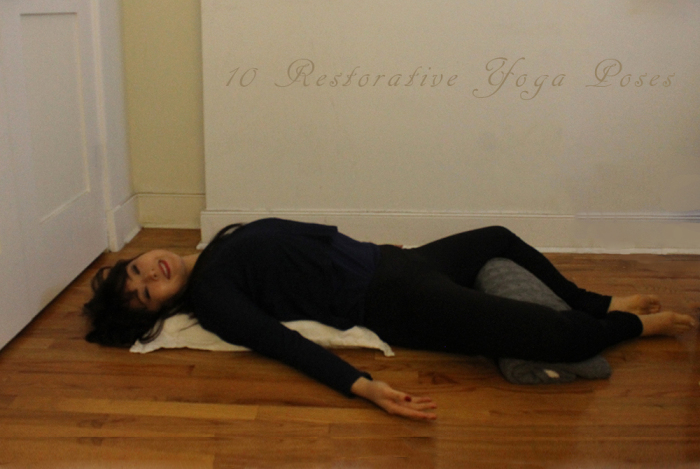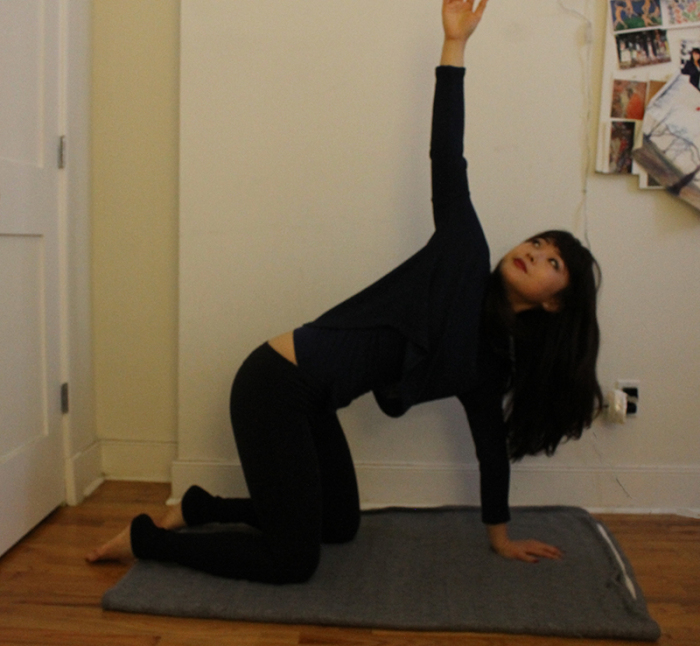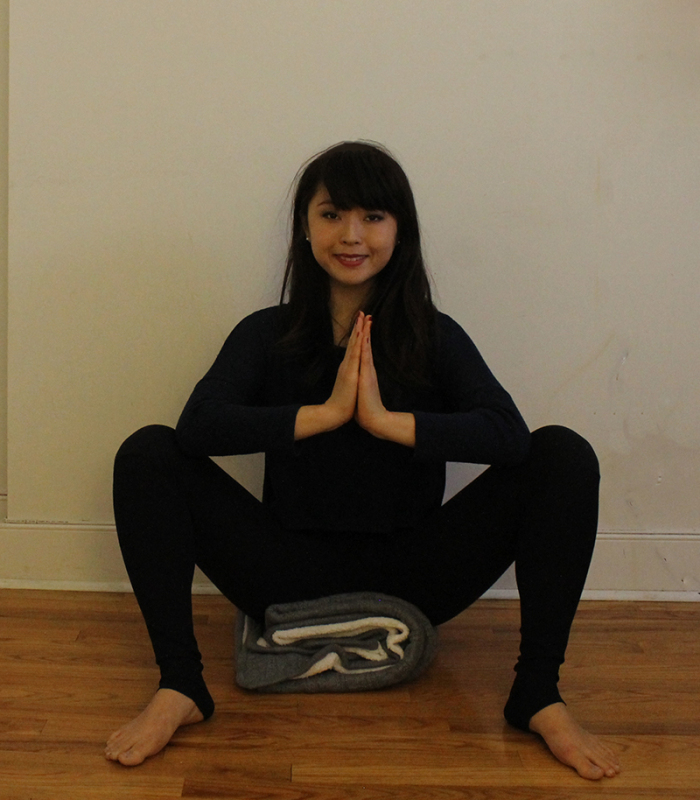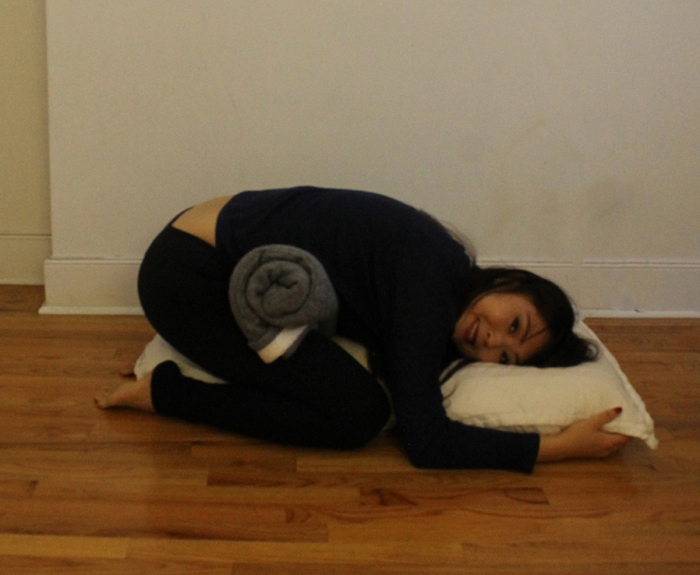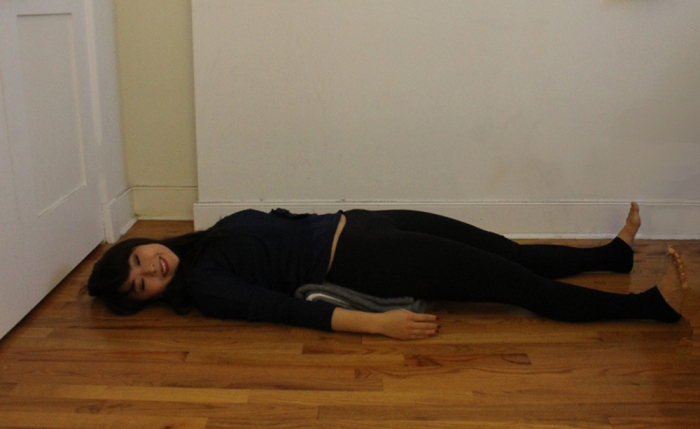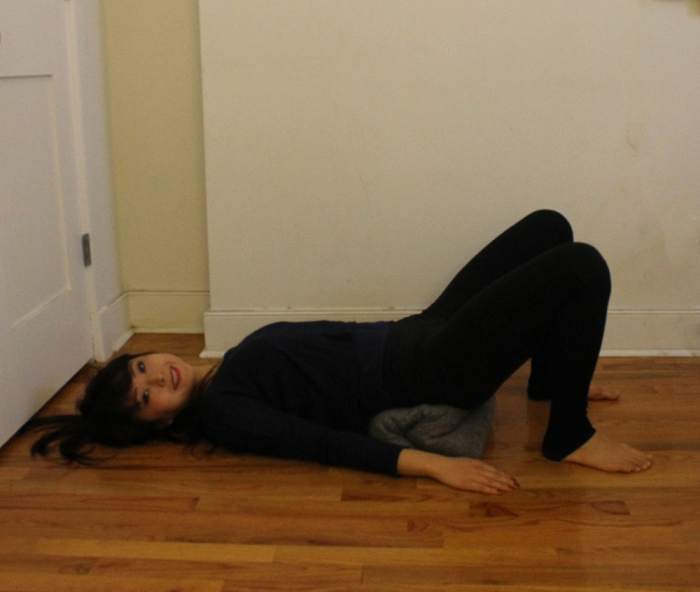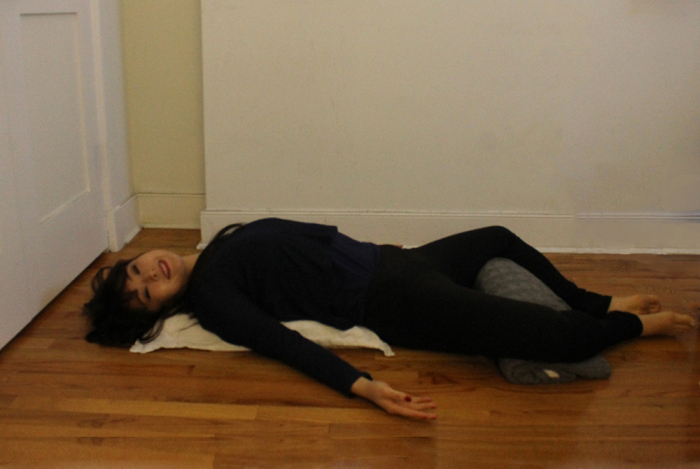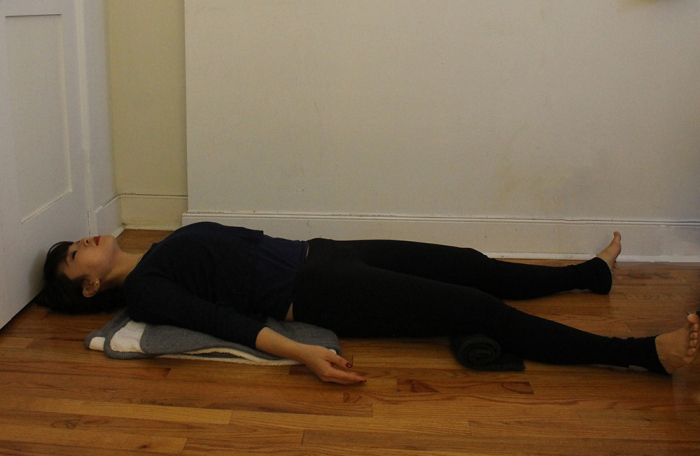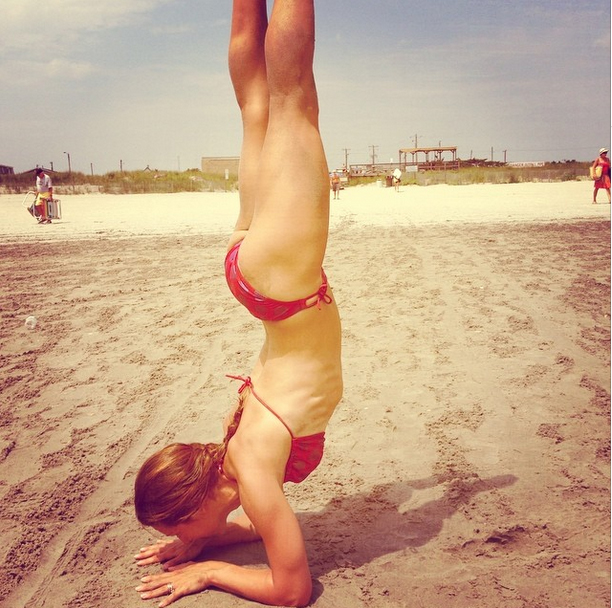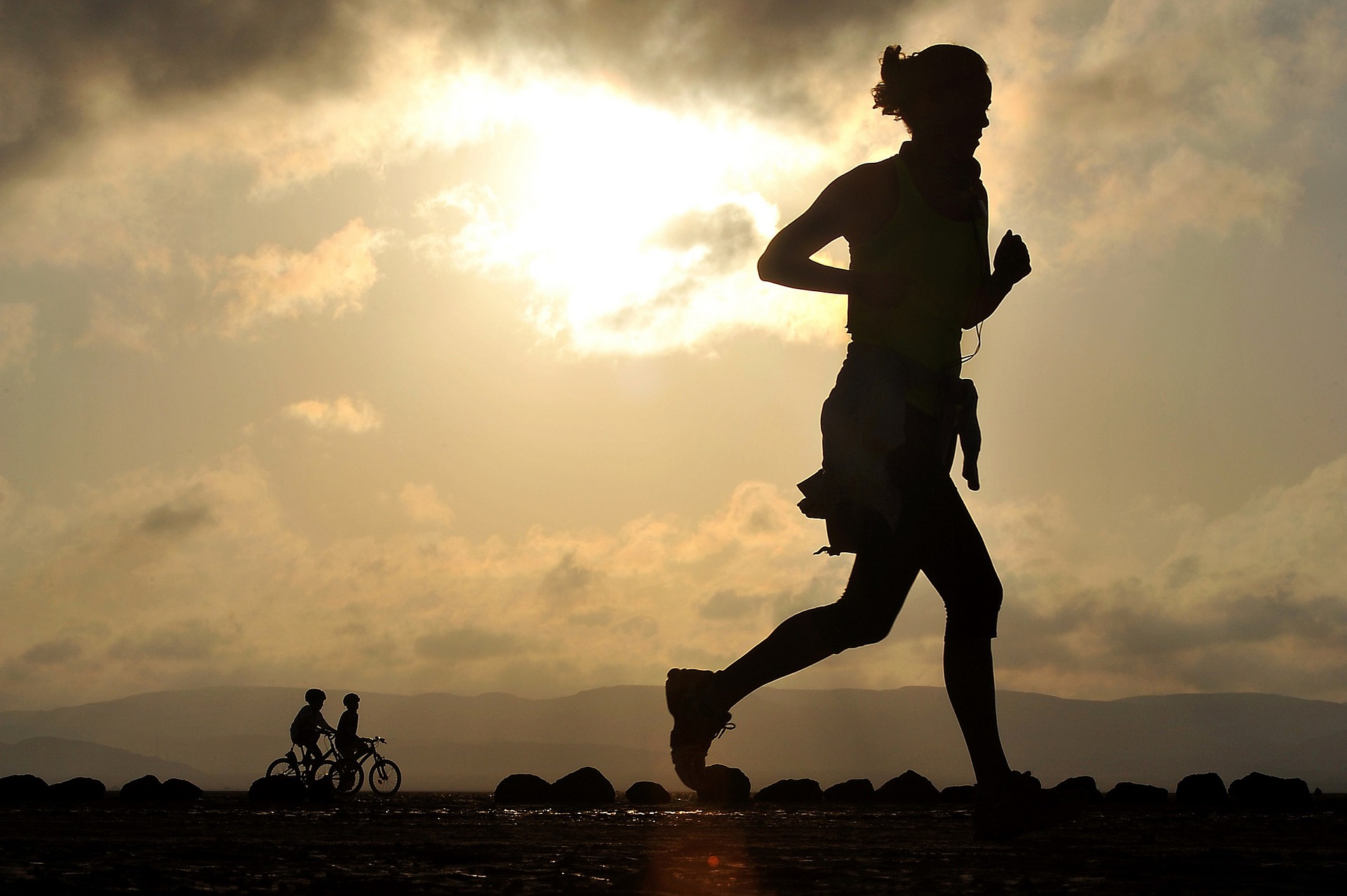I am always on the go, go, go. No matter how efficient I try to be with my work and chores, there always seems to be more. When I actually have a few hours of absolute free time, it feels awkward to not be trying to do anything.
Even yoga, one of my favorite ways to nourish myself, is almost always an opportunity to push myself. ‘Today I’ll get my standing split higher, and better balanced.’ ‘I’ll work on wrapping my core to balance better on my inversions.’ This motivation is helpful in pushing my boundaries, but also feeds my need to be in control all the time–in control of my breath, alignment, and balance on the yoga mat, but also in life. I seek to be in control over my path, my emotions, thoughts, energies–without ever pausing to check in with myself.
My normal vinyasa yoga practice, while calming on many levels, actually requires a lot of mental and physical control. These restorative yoga poses are the opposite. Instead of trying to fit the idea of the “correct” pose, restorative yoga poses allow you to let go and sink into what’s right for your body. In vinyasa you often aim to get straight into the right position (think about the ‘quick-twitch’ movements you need to get into a forearm stand, or jumping back straight into chaturanga dandasana with bent elbows); with restorative yoga, you might take a few minutes settling into a position and relaxing completely. I find that despite our great good will and positive motivation in January, right now is actually a time of year when our bodies should be resting and our spirits nourished gently–it’s still a hibernation time in nature. Our energies are lower this time of year so try not to be impatient and efficient all the time and balance your soul with these restful poses. For more winter-time appropriate relaxation, try a candle-lit session with soft music, around morning or dusk. (This is also a self-reminder for me–we’ll see how good I get at relaxing! 😉 )
1. Rolling Cat- Cow
Come onto your hands and knees. Gently breathe through a few rounds of cat and cow (exhaling out as you round the back and drop your head (cat), then inhaling, arching the back and looking up (cow)). Begin rolling your head, neck, shoulders, spine, tailbone and hips in a circular movement, or any way that feels natural to you, releasing tension through your entire spine.
2. Cat cow twist
From there, gently raise your right arm and twist from your navel, looking up at the ceiling and opening your heart. Breathe slowly here and then switch sides.
3. Supported goddess
Take a blanket and fold it in halves until you have a firm base of about 5-6 in. (You can of course use a yoga block too if you have one). Stand with your feet wider than hip distance, toes turned out. Sink down and bring your seat to the blanket. Bring your hands to prayer in front of your heart with your elbows pressing out against the inner thighs or knees. Release all contraction in your legs–if you feel tension in your legs, stack one more blanket or add a block until you can completely relax your seat and focus on releasing your hips open.
4. Legs up the wall (viparita karani)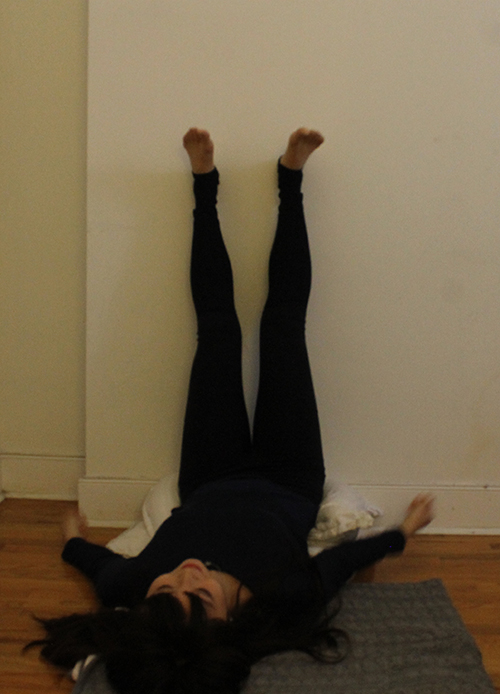
This pose is particularly good for anxiety, stress, and insomnia. You can practice legs up the wall without support, or with support. For supported pose, place a blanket or a firm pillow right underneath the arch of your spine (from your middle back, to small of your back, to your low back). Place a yoga block or two underneath your sacrum. Swing your legs up over the wall and breathe calmly–you may stay in this position for 5+ minutes.
Place a rolled blanket or a firm pillow on the floor and lower your seat onto the back end of it, with your knees on either side. Place another rolled blanket where your thigh meets the hip crease. Place another pillow in the front and hinge forward into a child’s pose.
Place a rolled blanket or a block underneath your sacrum. Relax your legs and send your hip bones heavy toward the ground.
6. Reclining hand to big toe variation (supta Padangusthasana)
From there, use your thigh muscles to lift your right leg close to your chest. Once it gets there, lightly grab your thighs or calves and gently pull, while sending your left hip heavy down toward the ground. Focus should be less on getting your right leg close to your chest, and more on getting your left leg as heavy and flattened as possible.
Roll a blanket firmly (or use a block) and lay it on the floor under your sacrum. Your feet should be wider than hip distance apart, flat on the floor, knees pointing up, and arms by your sides. Relax your seat and thigh muscles and just feel the calming effects of this gentle, effortless inversion (hips are higher than your head).
8. Reclining Bound angle pose (Supta Baddha Konasana)
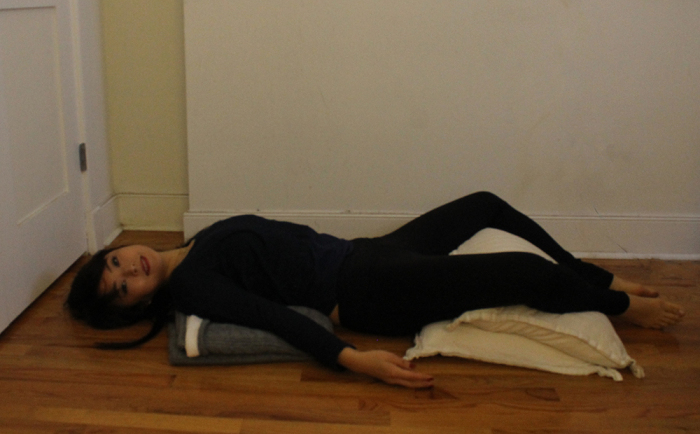
Experiment with different combinations of pillows, blankets, etc to get the support that’s right for you.
You can play with the kind of support (or no support) that you need with this restful, opening pose. The basic idea, if you use supports, is to support the arch of your back and your knees (which releases the tension in your lower back, thus making it easier for your hips to open up). Instead of focusing on forcing your knees to drop open and down, feel your sacrum and pelvis get heavy toward the floor and breathe into it to relax your his open.
9. Savasana with supported knees
Roll a blanket or a towel the long way and place it underneath your knees for gently supported savasana.
10. Bhairavi mudra
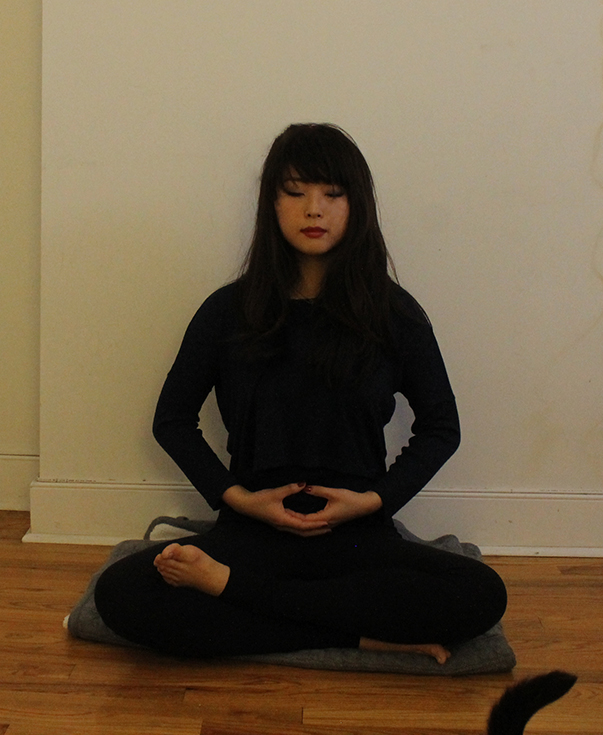 Place your left palm over your right palm and join the thumbs together as though holding an egg inside your hands. (Men dumplings, please place your right palm over your left). Place this lightly over your sacral plexus. The joining of the two hands in this circular shape represents the balance of our dual energies and is grounding. In bringing bhairavi over your sacral plexus, the chakra of our spontaneity, pleasure and emotions, you seek to let go–let go of the unceasing thoughts and perpetual need for control, and to live and appreciate the present in joy and fullness.
Place your left palm over your right palm and join the thumbs together as though holding an egg inside your hands. (Men dumplings, please place your right palm over your left). Place this lightly over your sacral plexus. The joining of the two hands in this circular shape represents the balance of our dual energies and is grounding. In bringing bhairavi over your sacral plexus, the chakra of our spontaneity, pleasure and emotions, you seek to let go–let go of the unceasing thoughts and perpetual need for control, and to live and appreciate the present in joy and fullness.
More yoga tutorials: Yoga for the New Year
Yoga for Invoking Your Inner Goddess
Gentle Yoga for Opening the Hips
__
Photo: Peaceful Dumpling

